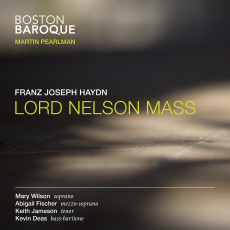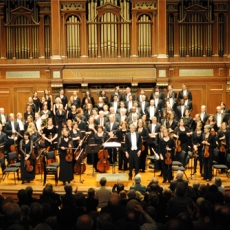Boston Baroque - Haydn: Lord Nelson Mass - Fanfare
Any new recording of the "Lord Nelson" Mass faces a huge challenge in this comer: The 1962 Decca/London recording led by David Willcocks has been on my all-time Want List for half a century ;for at least 10 years, it was one of the two most frequently played records in this household (alongwith Colin Davis's BBC Symphony "Eroica"). All succeeding "Nelson" Masses have fallen well short. Although Willcocks was leading the London Symphony Orchestra, at that time perhaps the most glorious of orchestras, the performance was based on a well-researched score and took a decided stance toward period practice. It does not sound out-of-date today and rings as true as it did then.
Martin Pearlman and his Boston Baroque have become the standard setters for period practice in America, and they nailed down that reputation with a Haydn Creation which I found to be the finest ever (Fanfare 36:3). This "Nelson" Mass is another superb achievement. The period orchestra (strings 6/5/4/4/2) nearly matches the LSO in splendor and outpoints it in precision and energy. Pearlman's violins are especially effective in quiet passages, where their color and purity gleam. In the many places, Willcocks's Choir of King's College, Cambridge tends to overwhelm the vocal soloists with its glorious panache; the Boston chorus (6/5/5/5) is more-subtle, supporting the soloists without ever obscuring them. Pearlman's vocalists sing more stylishly than their Decca counterparts (both performances use Haydn's original scoring, before he simplified some of the vocal lines), but there are moments where the full operatic glory of Sylvia Stahlman and Tom Krause conquer all. Bass-baritone Kevin Deas is marvelous, but no one has ever matched Krause's thrilling gravitas inthe Qui Tallis. The organist is not credited in the Linn booklet; perhaps it is Pearlman, but the conductorhas a lot to do during the "Nelson" Mass.
The biggest difference between the two performances is on the podium – or at the keyboard. Willcocks goes for heavy drama, reveling in suspense and mystery (Haydn called this work Missa inangustiis, "Mass in time of anxiety," as Napoleon's armies threatened Vienna). Pearlman, at faster tempos (except in the Sanctus and Benedictus) goes for spirit, with a consistent spring and life beyond that in the English performance. Both approaches work perfectly in this masterpiece, and both realizations are internally consistent, creating two very different wholes that are equally convincing, equally thrilling. Remembering where I am coming from (stated at the beginning of this essay), that is the highest possible praise. The two recordings complement each other rather than competing.
The Linn recording, from Mechanics Hall in Worcester, Massachusetts, is a fine one. The realistic balances have the vocal soloists up front with the orchestra, the chorus in the rear. The acousticis quite reverberant, which serves the whole well, but the more distant chorus is a bit blurred; we miss the feeling-present in the Linn Creation from the same hall-that we can almost distinguish each individual voice in the chorus. SACD solves the problem and makes a big improvement with the chorus in particular. Surround sound involves the listener even more closely in the performance, but the chorus is again less distinct, so I prefer just plain SACD. Although more than 50 years old, the Decca analog stereo more than holds its own. It's a fine idea to pair one of Haydn's greatest symphonies with perhaps his greatest work. Here at last is a period-instrument performance of a "London" symphony that can stand up to those by the best symphony orchestras – Bernstein's New York Philharmonic and Colin Davis's Concertgebouw, among others – although neither Boston Baroque nor the Philharmonic can match the beauty of the Concertgebouw woodwinds. Pearlman takes consensus tempos throughout. All of Haydn's "London"Symphonies except the C Minor begin with a slow introduction, and all but this Bb Symphony start with Adagio; here it is Largo. Only Bernstein takes it really slowly, and it is most effective at his tempo. Pearlman begins the Vivace at a quick pace but soon settles back into the same tempo as Bernstein; Davis keeps up the speed. Pearlman repeats the first (20-bar) section of the Menuet da capo but not the second (64-bar) one, which works well. The Finale is a Presto, but Davis and Pearlma nare fairly cautious, whereas Bernstein is daringly, breathtakingly fast. Most importantly, Pearlman breathes life into every phrase througout the Symphony and the Mass.

